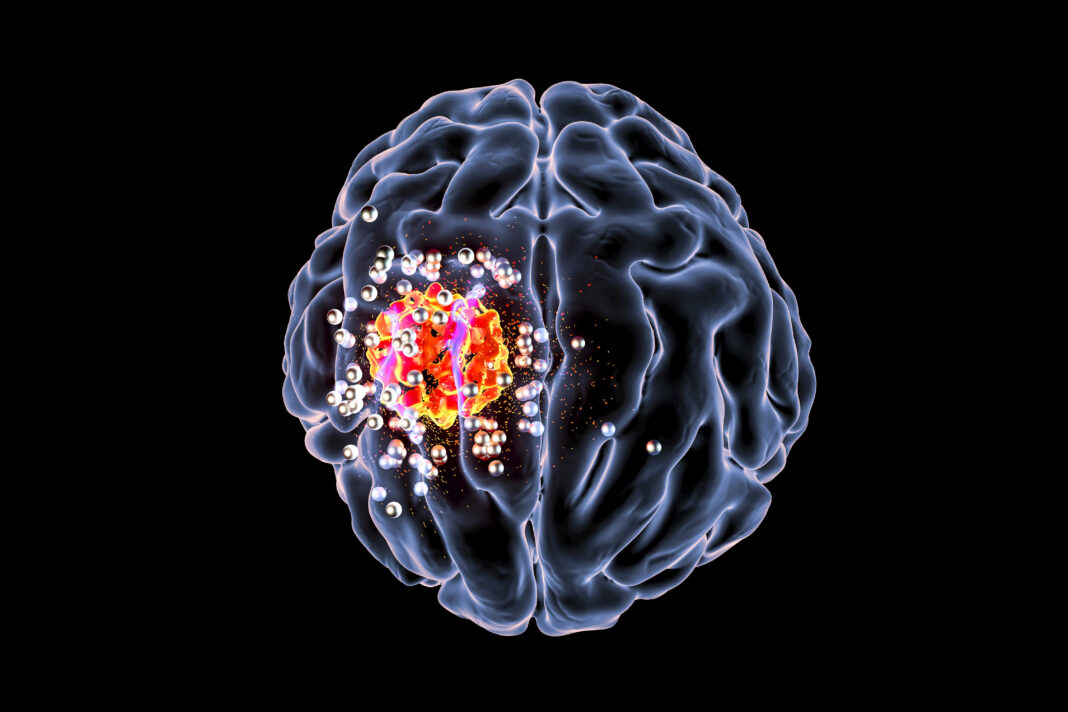The first in-human trial to use a novel ultrasound device to temporarily open the blood-brain barrier to deliver chemotherapy reveals that the procedure led to an increase in drug concentrations in the human brain. Low-intensity pulsed ultrasound with concomitant administration of intravenous microbubbles (LIPU-MB) has been shown to open the blood-brain barrier. The new study sought to assess if LIPU-MB could enhance the delivery of albumin-bound paclitaxel to the peritumoural brain of patients with recurrent glioblastoma.
This research is published in The Lancet Oncology in the article, “Repeated blood–brain barrier opening with an implantable ultrasound device for delivery of albumin-bound paclitaxel in patients with recurrent glioblastoma: a phase I trial.”
There is currently no effective treatment for glioblastoma. One of the major impediments to treating the deadly brain cancer is that the most potent chemotherapy can’t permeate the blood-brain barrier. Findings from a new study suggest that a novel, skull-implantable ultrasound device opens the blood-brain barrier and repeatedly permeates large, critical regions of the human brain to deliver chemotherapy that was injected intravenously.
The four-minute procedure to open the blood-brain barrier is performed with the patient awake and patients are able to go home after a few hours. LIPU-MB with intravenous albumin-bound paclitaxel infusion was done every three weeks for up to six cycles. Six dose levels of albumin-bound paclitaxel were evaluated. The results show the treatment is safe and well tolerated, with some patients getting up to six cycles of treatment.
This is the first study to successfully quantify the effect of ultrasound-based blood-brain barrier opening on the concentrations of chemotherapy in the human brain. Opening the blood-brain barrier led to an approximately four- to six-fold increase in drug concentrations in the human brain, the results showed.
In addition, this is the first study to describe how quickly the blood-brain barrier closes after sonication. Most of the blood-brain barrier restoration happens in the first 30 to 60 minutes after sonication, the scientists discovered. The findings will allow optimization of the sequence of drug delivery and ultrasound activation to maximize the drug penetration into the human brain, the authors said.
The scientists discovered that the use of ultrasound and microbubble-based opening of the blood-brain barrier is transient, and most of the blood-brain barrier integrity is restored within one hour after this procedure in humans.
“There is a critical time window after sonification when the brain is permeable to drugs circulating in the bloodstream,” said Adam Sonabend, MD, associate professor of neurological surgery at Northwestern University Feinberg School of Medicine.
Previous human studies showed that the blood-brain barrier is completely restored 24 hours after brain sonication, and based on some animal studies, the field assumed that the blood-brain barrier is open for the first six hours or so. The current study shows that this time window might be shorter.
In another first, the study reports that using a novel skull-implantable grid of nine ultrasound emitters designed by French biotech company Carthera opens the blood-brain barrier in a volume of brain that is nine times larger than the initial device (a small single-ultrasound emitter implant). To be effective, this approach requires coverage of a large region of the brain adjacent to the cavity that remains in the brain after removal of glioblastoma tumors.
The findings of the study are the basis for an ongoing Phase II clinical trial the scientists are conducting for patients with recurrent glioblastoma. The objective of the trial—in which participants receive a combination of paclitaxel and carboplatin delivered to their brain with the ultrasound technique—is to investigate whether this treatment prolongs survival of these patients.
“While we have focused on brain cancer (for which there are approximately 30,000 gliomas in the United States), this opens the door to investigate novel drug-based treatments for millions of patients who suffer from various brain diseases,” Sonabend said.


